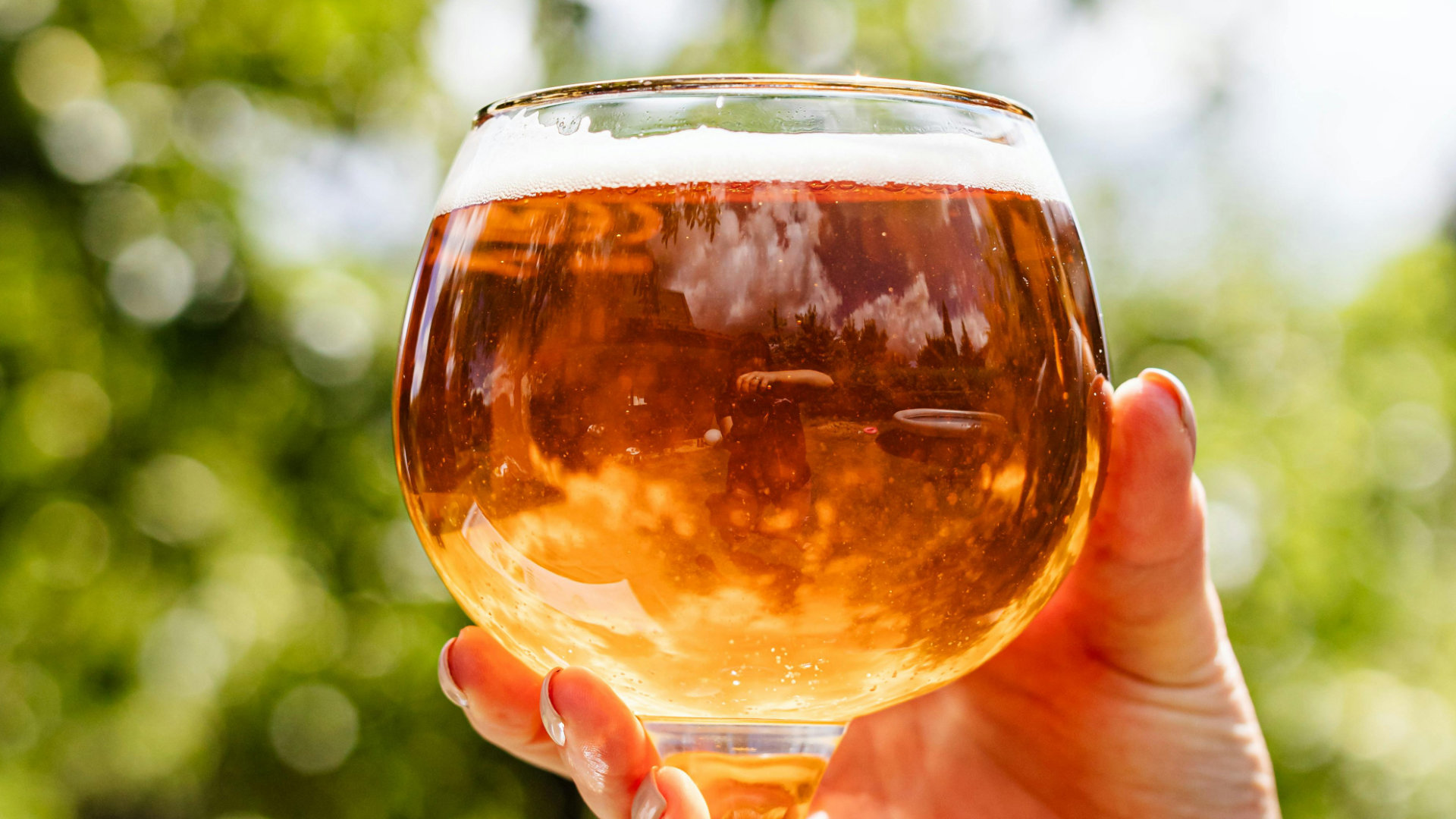It’s easy to slip into routines: there’s a certain safety in knowing what you do and don’t like. We all have our go-to beers, for sure, but life can get a bit, you know, stale when you always go vanilla (or IPA). There’s just no thrill. And no learning.
The Wild Beer Co are on a mission to change that with exciting, complex, wild beer. What they do challenges people’s perceptions of what beer is, brewing full-flavoured beers with unusual ingredients and yeast strains. Celebrating traditional techniques with a fresh, modern twist.
Founded in October 2012 by Andrew Cooper and Brett Ellis, The Wild Beer Co produce their boundary-pushing beer from their farmhouse brewery, idyllically set amongst the rolling Somerset hills. This, they say, gives them a pretty unique terroir.
In addition to their love of wild fermentation, one of the not-so-secret secrets to their award winning brews is barrel-ageing and blending. ‘We see wood and barrel-ageing as the medium that turns an ordinary beer into an outstanding taste-experience.’ they reveal on their website.
Head over to www.wildbeerco.com and you’ll see just how ‘wildly different’ their creations are. Take their vinously inspired beer, ‘Murmur’: wine yeasts, aromatic malts and Ekuanot, Nelson Sauvin and Hellertau Blanc hops bring sweet, dry, bitter and acid elements to produce a clean, crisp and wonderfully unique beer. Drinkable yet dynamic. And a fantastic food pairing beer as a refreshing change to white wine.
Indeed, all of their brews come with great food pairing suggestions. Which makes total sense given Brett’s previous life as a food creator. US born Ellis started as a chef in California, which gave him an inspiring headstart when it comes to flavours and the experience of the brew, not just through taste and aroma but also the environment in which its enjoyed. “One of my core drivers is that flavour draws people togetherâ€, he says, “it’s all about creating a space were we flock to and life happens.
I was hungry to discover more and caught up with Head Brewer Brett to talk about wild brewing, yeasts ...and finger painting.
Tell us about wild brewing! What makes it different from ‘regular’ brewing and why does it fascinate you so much?
Wild Brewing is so great because it’s full of curiosity, flavour and magic; wild brewing is all about the journey, and the destination is what you make of it. And you better be up for the excitement of having curveballs thrown at you!
When you set out to make a 6% IPA, for example, you want to control all the factors. If you practice and hone all those things (ingredients, processes, etc) you’ll be on the journey to crafting the world’s best IPA made at your home.
When you are brewing with wild yeasts you still seek to control aspects of the whole process, but you’re ultimately seeking to let go of the reins and let the organisms do their thing. I like to see our role as brewers in this process is more akin to a steward, or better yet maybe a 3-year-old’s art teacher. The skill of the art teacher is to know when to take away the painting and when to let them carry on. There is always a point were the painting looks amazing and it’s often just before it turns into a mess.
You get it? As wild brewers and blenders we have to create the environment and boundaries for the yeast and microbes to play and do the thing they do best. Just like the 3-year-old. Instead of paint, brushes and paper we have wort, oxygen, fermenting vessels, yeast or organism strains, pitching rate, time, temperature, etc…etc…
Tell us a bit about the yeasts involved.
We, in our culture and in nearly every culture, prize and seek out the flavours and aromas of fermentation (not to mention the superpower of fermenting as a way of preserving crops and proteins without any need for refrigeration or cooking!). Using wild organisms such as Brettanomyces, Lactobacilli or Pediococcus create those fermentation aromas and flavours that we are all attracted to. Brettanomyces can transform the aromas that Pediococcus creates into novel hits of guava and mango, or may itself create some really cool notes of ripe strawberries, tart cherries. Our cultures tend to give some amazing elderflower notes.
We use Brett-b in our Modus Operandi wild beer to get some cherry notes. If you make a great example of an English old ale or Scottish strong ale then age it in a glass or steel fermenter for about 90 days with healthy Brett-b to get some tart cherry flavours and aromas. But to be clear: those are flavours and aromas not actual sourness. You will need to pitch Lacto and/or Pedio to make sourness. I would suggest you age two thirds with Brett and one third separately with the bacteria, then blend them to suit your flavour after 3 months to 2 years or ageing. Yes, I said up to two years!
We love your Liripip table beer. How do you get all the flavour but less ABV?
I am a big fan of low alc beers! They’re probably some of my favourites. Don’t get me wrong, I love me some stronger Verdant, Vocation and DEYA hop juice masterpieces, but my go-to beers are 5% and under; and I love the flavours in lower ABV drinks. Over the last eight years of building, brewing and discovering the Wild Beer Company we‘ve unearthed some cool ways of packing the flavour in without all the alcohol. A few points to focus on are:
Yeast: choose one that can give off either body to the beer or leave more malty goodness behind. So, either a low attenuating Scottish ale yeast or a saison yeast that may give off loads of glycerol, which is perceived as body in the beer so it’s not too thin - even though saison yeasts are hungry little buggers. The right yeast for you and your beer might actually be a blend of yeasts!
Lower carbonation will help the malt shine through the cold serving temperature and the hops. If you have ever had an over carbonated beer you’ll realise that there is very little body, and the mouthfeel is prickly and effervescent rather than smooth or filling. Choose a smoother and more filling CO2 level: aim for 2,1-2,3 vols CO2.
Use Adjuncts: one of the challenges with lower alcohol beers is that you’re not using as much malt and, possibly, hops. So you may find that adding in a pinch or two of a spice, herb, fruit or the like will give you that little edge of balance or depth of flavour. I’m not talking about going full-on spice or fruit beer, I’m talking about mimicking the characters of a higher ABV fermentation.
You have a clear passion for flavour; where do you get the inspiration for all your incredible flavours?
It might sound lame, but maybe it’s by seeing ‘beer’ as an addition or a medium to work with rather than the other way round. It’s good to look at your work from different angles. For example, using acid as a flavour addition is really curious. I don’t necessarily mean adding acid to your beer, although there is a place for that in good brewing practices. I mean using blending (mature sour beer, fruit juices, other fermentations) or mixed fermentation to create acids which create juiciness or balance in a way that standard brewing cannot.
Read more about The Wild Beer Co and order their wild beer, alco-free fermented sodas and craft gin online at
wildbeerco.com.
They’re launching an exciting new beer this autumn and have more cool things in their pipeline, so sign up to their newsletter and follow them at
@wildbeerco to be in the know!











